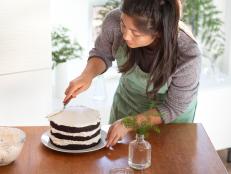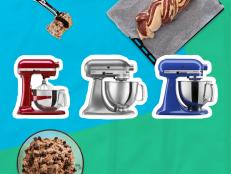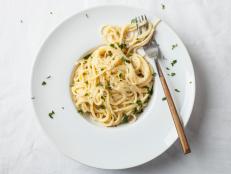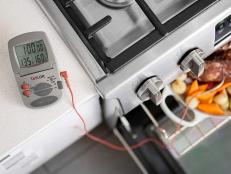What Brain Cancer Taught Me About Baking Cake
How one woman's diagnosis led to a slew of brand new recipes.

From Cake Magic! Workman Publishing. Photo by Ken Carlson
Terminal cancer is difficult to understand: Its victims are often random and anyone close to someone with a diagnosis like that feels immediately and suddenly helpless. I was not unique in feeling swept under when I was told the likely benign, likely juvenile tumor in my head was instead the most aggressive brain cancer diagnosis possible, a glioblastoma. My hard-wired optimism was suffocated by my cancer diagnosis, choking on hopeless odds and statistics.
I immediately rushed into action. The steroids I was on made me terrifyingly unstoppable, but so did my motherhood to two beautiful little boys. My schedule had been particularly crazed before my diagnosis — I had just finished the tour for my second cookbook, Cake Magic!, and handed in the manuscript for my third when I began to notice my symptoms. As my lens to express and experience life has always been food and cooking, the first solution I came to after my diagnosis was, of course, to find a new way of feeding my body, to consider advice I would have otherwise dismissed throughout my career.
My team at the brain cancer clinic was disinterested in my diet; their focus is to treat symptoms first. It became clear that no one place was going to prescribe this change for me, so I dove in. I immediately consulted a homeopath and started to research diets. When I considered my own, though full of vegetables and variety, it was also full of sugar and little moderation.
I devoured outlines of anti-inflammatory diet principles, which I combined with my food-world common sense. I cross-referenced diets that my homeopath suggested full of buzzwords like "alkaline," "anti-cancer," and "gut health." The advice I kept finding on the Internet, reiterated by my homeopath and friends who practice ayurvedic medicine, repeated a few common offenders. Almost overnight, I decided to cut out gluten, chocolate, sugar, soy, coffee, potatoes, corn, certain beans and pork in favor of an alkaline, anti-inflammatory diet all my own. On this new diet, I couldn’t even enjoy any cakes I had developed for my beloved book, Cake Magic!. I felt like I had sacrificed my career at the altar of health, though I felt strongly that the change in my diet would at least affect the experience of my cancer, if not my outcome.
My appearance changed immediately. Despite undergoing intense treatment like daily radiation doses that culminated just under the limit for brain necrosis combined with daily chemo, I grew healthier. I shed weight slowly as I walked to yoga and my son to preschool. My skin took on a healthy flush, my brain felt clear in a way I hadn’t realized it was foggy. I never found the symptoms the nurses cautioned me to look for — my energy held on through six weeks of radiation full of daily exercise, writing, and parenting two little boys.
My scans were coming back clean. It was unheard of. More statistics, more guesses were tossed at us by the doctors in a landscape they openly began to admit was entirely unfamiliar.
Changing my diet to survive was easy — the stakes were very high and each day, every meal, felt like a desperate fight to survive. Living, however, the way I do with my life full of good food and flavor, meant that I had to find a way to cook and bake again that honored my work as well as my cancer. One day, I fiddled with a cake recipe I was making to celebrate the year anniversary of my brain surgery — one the doctors told me I likely wouldn’t see. In that moment, I decided to make a grain and refined sugar-free mix for Cake Magic! that could translate the entire book of over 100 cakes into recipes I could eat again. Suddenly I was working on an official addendum to the book and just as suddenly I felt truly alive again.
The same voice inside me that led me to my diet choices compels me to share here at the end of what feels like a very tidy, very dramatic cancer success story: I was always an outlier and remain so today. My health success is due first to my surgeons and exceptional treatment, then also to luck and my age. I don’t feel like I "beat" my cancer or even that it can be, but I do believe that being kind in the form of conscious, gentle diet choices on a stressed immune system can give a patient hope and control. And, quite possibly, a whole new life.
How the Cake Magic! Addendum Works
This is the official addendum for Cake Magic! — it’s intended to be printed, folded up and sandwiched into the book. Here’s how it works: The bulk of the Cake Magic! book is photos of cakes with a strip of "cake math" at the bottom of the image. That equation points you to a layer cake, a frosting and a syrup to use to replicate the cake in the photo. The back of the book contains the recipes — cake layers, frostings and syrups — along with simple variations for each that transform the flavors further. This addendum includes instructions for diet-friendly cake mixes and instructions on how to transform the remaining recipes in grain and refined sugar-free ways. Basically, it unlocks Cake Magic! for bakers who avoid grains and refined sugars, like me.
Give it a try with the recipe for the Cake Magic! Vanilla Cake below.

From Cake Magic! Workman Publishing. Photo by Ken Carlson
Makes one 8- or 9-inch double-layer cake (or one 10-inch bundt cake, one 9 by 13 sheet cake, or 24 cupcakes)
Ingredients
Unsalted butter, at room temperature, for greasing the pans
All-purpose flour, for dusting the pans
4 cups Paleo Cake Magic! Cake Mix, whisked well before measuring
3/4 cup full-fat plain yogurt (preferably not Greek yogurt)
1 cup (2 sticks) unsalted butter, melted and cooled
3/4 cup water
2 teaspoons pure vanilla extract
4 large eggs, at room temperature
Directions
1⋅ Preheat the oven to 350 degrees F. Butter the bottom and side of the pan(s). Dust with flour to coat, then invert and tap out any excess. (If making cupcakes, use liners instead of greasing and coating the tins.)
2⋅ Place the cake mix in a large bowl. Stir in the yogurt, butter, water, vanilla, and eggs until moistened and no lumps remain (be careful not to overmix).
3⋅ Bake until the layers are domed and golden brown, and a few moist crumbs cling to a skewer inserted in the center of the cake, 35 to 40 minutes (40 to 50 minutes for a Bundt, 25 to 30 minutes for a 13 by 9-inch cake, and 20 to 25 minutes for cupcakes). Transfer the cakes to a wire rack to cool completely.
4⋅ When they are cooled, one to two hours, carefully turn them out of their pans and assemble and frost.
BUY IT: Cake Magic!; Amazon, $17.95


































